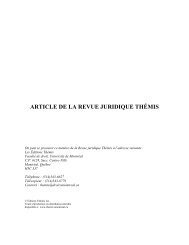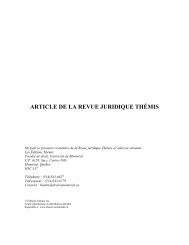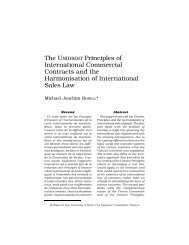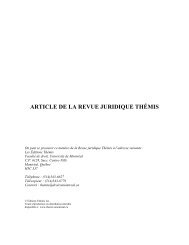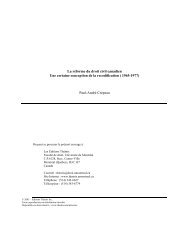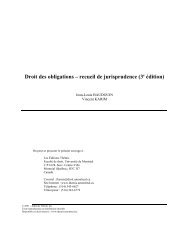Harmonisation, unification et uniformisation. Plaidoyer pour un ...
Harmonisation, unification et uniformisation. Plaidoyer pour un ...
Harmonisation, unification et uniformisation. Plaidoyer pour un ...
You also want an ePaper? Increase the reach of your titles
YUMPU automatically turns print PDFs into web optimized ePapers that Google loves.
HARMONISATION, UNIFICATION ET UNIFORMISATION 633<br />
b. Les savigniens : tenants d’<strong>un</strong>e harmonisation<br />
progressive du droit européen des contrats<br />
Les opposants à l’idée d’<strong>un</strong>e codification militent plutôt <strong>pour</strong><br />
<strong>un</strong>e approche d’harmonisation progressive du droit des contrats 74 .<br />
De leur point de vue, le droit ne doit pas émaner d’<strong>un</strong>e législation.<br />
Au contraire, les savigniens souhaitent <strong>un</strong>e harmonisation du droit<br />
européen des contrats sous l’impulsion du peuple <strong>et</strong> des <strong>un</strong>iversitaires.<br />
Comme le rapporte le professeur Lando :<br />
« [a] European Contract Law, the Savignys say, should grow organically<br />
and slowly in the people, led by the academics and supplemented<br />
by the business comm<strong>un</strong>ity when it feels the need. In their<br />
international organisations the business people should establish<br />
common customs and practices. Arbitrators apply general principles<br />
of law (the lex mercatoria) to international commercial disputes<br />
should provide a common core of contract rules. » 75<br />
C<strong>et</strong>te conception suppose alors <strong>un</strong>e construction graduelle d’<strong>un</strong><br />
corpus normatif intégré à partir de la seule expérience de la vie du<br />
droit dans l’ensemble des sociétés concernées. À c<strong>et</strong> égard, le professeur<br />
Bonell s’est en quelque sorte fait le héraut des savigniens en<br />
avançant trois principaux arguments justifiant <strong>un</strong>e harmonisation<br />
progressive du droit 76 .<br />
Il rem<strong>et</strong> d’abord en question l’opport<strong>un</strong>ité d’<strong>un</strong>e codification en<br />
Europe. Aussi, est-il d’avis que la coexistence en Europe de plusieurs<br />
régimes juridiques des contrats ne pose pas de problème si<br />
grave qu’il faut le résoudre par l’élaboration d’<strong>un</strong> code européen des<br />
contrats 77 . Le professeur Glenn abonde dans le même sens lorsqu’il<br />
estime que la multiplication des échanges dans <strong>un</strong> marché comm<strong>un</strong><br />
74 Voir notamment Reinhard ZIMMERMANN, « Savigny’s Legacy. Legal History Comparative<br />
Law and the Emergence of a European Legal Science », (1996) 112 L.Q.R.<br />
576-605 ; Basil S. MARKESINIS, « Why a Code is not the Best Way to Advance the<br />
Cause of European Legal Unity », (1997) 5 Euro. Rev. Priv. L. 519-524 ; Michael<br />
Joachim BONELL, « The Need and Possibilities of a Codified European Contract<br />
Law », (1997) 5 Euro. Rev. Priv. L. 505, 506 ; Otto KAHN-FREUND, « Common law<br />
and Civil Law – Imaginary and Real Obstacles to Assimilation », dans Mauro<br />
CAPPELLETTI (dir), New Perspectives for a Common law of Europe, Bruxelles, Bruylant,<br />
1978, p. 137, aux pages 142 <strong>et</strong> 143, ainsi que P. LEGRAND, préc., note 60, 56<br />
<strong>et</strong> 58.<br />
75 O. LANDO, préc., note 17, 531.<br />
76 Voir M. J. BONELL, préc., note 74, 506.<br />
77<br />
Id., 516.



